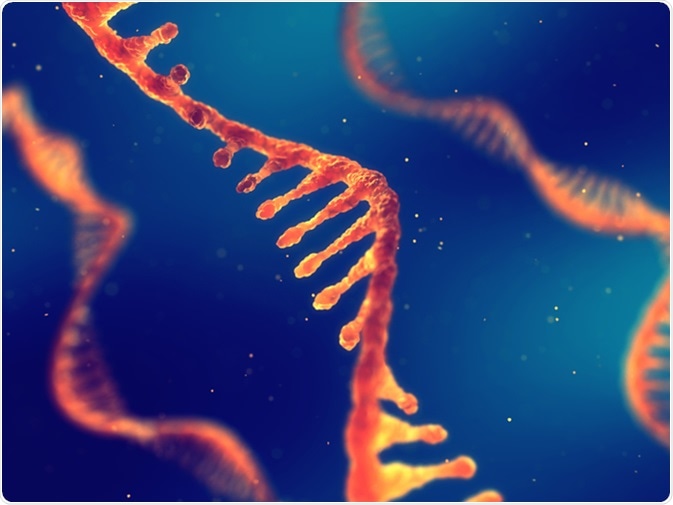Single cell RNA-sequencing measures the distribution levels of each gene across of population of cells. This can be used to study the development and physiology of cells, as well as disease.
Single cell RNA-sequencing (scRNA-seq) allows for the gene expression patterns of individual cells be defined. As cells have different gene expression, using scRNA-seq describes the phenotype of a cell and its molecular functions.

Single strand ribonucleic acid, RNA research and therapy, 3d illustration. Image Credit: Nobeastsofierce / Shutterstock
Methodology of Single Cell RNA-Sequencing
scRNA-seq involves the reverse transcription of RNA into cDNA, which then undergoes DNA sequencing. Genes that are highly expressed within a sample produce more RNA, cDNA, and DNA than genes that are weakly expressed. scRNA-seq is performed in many steps, which are organ dissociation, single-cell capture, cell lysis, reverse transcription, amplification, library preparation, sequencing, and finally analysis.
Many scRNA-seq methods allow for the mass DNA analysis of a large number of cells. Gene expression data can be provided for up to 96 cells in a single run using the Fluidigm C1 microfluidics system of scRNA-seq. High-throughput Fluidigm IFC chips allows for up to 800 cells to be examined at once.
More common scRNA-seq methods use microdroplets instead of microchambers. This allows for up to hundreds of thousands of microdrops to be generated very cheaply. The microdrops are surrounded by oil and contain a bead with a uniquelt barcoded set of oligonucleotides as well as a single cell. After cell lysis the oligonucleotides hybridize to the polyA tails of the released mRNAs. For Drop-seq, the beads (which are attached to the oligonucleotides and mRNAs) are released from the drops and combined into a tube. Now reverse transcription can occur. For InDrop, the beads dissolve in the microdrops which releases the oligonucleotides to hybridize with the mRNAs, and the reverse transcription is carried out within the drops. Both methods allow for the incorporation of the bead-specific barcode into the cDNA, which allows the subsequent DNA sequence reads to be aligned with a specific cell.
scRNA-seq can also be carried out on microwell plates by performing RNA-seq on cells that are isolated via fluorescence-activated cell sorting (FACS). Many different methods of amplification can then be performed including SMART-seq2 chemistry, Cel-seq, MARS-seq, and STRT-seq. SMART-seq2 and STRT-seq amplify cDNA reverse transcription products with PCR, but Cel-seq and MARS-seq incorporate a bacterial virus promoter into the cDNA, amplification is done by in vitro transcription.
Experiments involving scRNA-seq must be designed with consideration of cell numbers, reads per cell, and biological replicates. Each different scRNA-seq technology will have different thresholds for the maximum number of sequence reads per cell. The similarity of cells types being analysed determines which sequencing technology is used.
Single Cell RNA Sequencing - Finding a cure for DIPG
The Uses of Single Cell RNA-Sequencing
There are many applications for scRNA-seq, which provides information about cells and diseases. Performing scRNA-seq on tumor cells can enable separation of tumour fibroblasts from endothelial and cancer cells, based solely on their gene expression signatures.
scRNA-seq can be used to study the development of organs and tissues. Better understanding of the exact gene expression programmes that drive the differentiation pathways which cause different cell types would improve understanding of organ development.
Disadvantageous When Using Single Cell RNA-Sequencing
The main challenge with single-cell studies is the small amount of material that is available to work with. Each cell only contains ~0.1 picograms of mRNA. This is the reason that every scRNA-seq technology requires an amplification step to provide more material to work with.
Breaking down an organ or tissue into a single cell for analysis can be very difficult. Micromanipulation uses forceps, a micropipette, and a microscope to isolate single cells from histological sections. This is a very labour-intensive method that provides very good results. Laser capture microdissection (LCM) uses a laser to excise cells from cryostat sections, another labour-intensive process.
When performing scRNA-seq noise occurs due to the sporadic way in which genes are expressed. Not all cells express the genes at the same time, and not all cells that are analysed are at the same points within the cell cycle. This is what can alter the results and produce noise.
In conclusion, scRNA-seq is a very versatile experimental method. There are many different technologies that can be used to perform the experiment, each with their own advantages and disadvantages. There are many variables that must be considered when picking which technology to use. scRNA-seq can give extremely detailed information regarding a cell and can be used to discover many different things regarding cell physiology and development.
Further Reading
Last Updated: Aug 23, 2018